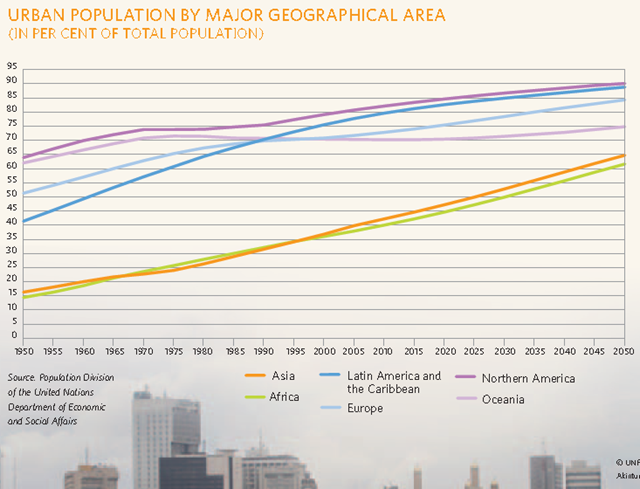Graph of the Day: Urban Population By Major Geographical Area, 1950-2050
In this world of 7 billion people, the global rural-urban balance of populations has tipped irreversibly in favour of cities. But what, exactly, is a “city” in 2011? Hania Zlotnik, the director of the Population Division of the United Nations Department of Economic and Social Affairs cautions against assuming too easy a definition because governments and urban areas themselves define “city” in numerous ways and their boundaries can shift, sometimes for political, demographic or economic reasons. Metropolitan areas spreading over large territory are absorbing or overtaking compact cities, sometimes merging with other metros along heavily populated corridors. Urban populations may also be counted in different ways from country to country or city to city. The Population Division’s World Urbanization Prospects: The 2009 Revision calls these huge population centres “urban agglomerations.” Tokyo emerges as the world’s largest urban area under this definition, with 36.7 million people, which is more than a quarter of the national population. Tokyo is followed by Delhi, with 22 million; São Paulo, 20 million; Mumbai, 20 million; Mexico City, 19.5 million; New York-Newark, 19.4 million; Shanghai, 16.6 million; Kolkata (Calcutta), 15.5 million, Dhaka, 14.7 million, and Karachi, 13 million. Each of these cities reflects a different pattern or path of planning and governance and a different composition of affluence and poverty. Without planning, cities can grow absent-mindedly, spread over every available empty space and overrun the ability of public services, where they exist, to meet demands or cope with the growth of slums. Property developers, corporations, migrant workers, government bureaucracies, and public institutions seeking room to expand all play roles in the growth, reshaping or, lately in a number of countries, contraction of cities. While many cities face overwhelming challenges, others have the potential to bring the benefits of urban life to their residents.
People and Possibilities in a World of 7 Billion [pdf]
